Noise and Noise Reduction (JPEG)
Note: this page uses our interactive noise comparison
widget. By default, we show you the default settings to reduce noise of the
camera tested, and three other models of the same series. You can choose from
the available NR options, and from the other cameras. The 'tricolor' patches
beneath the similar gray/black/portrait photos are shot from the same test
chart, and show how noise impacts upon blue, green and red regions of the
scene.
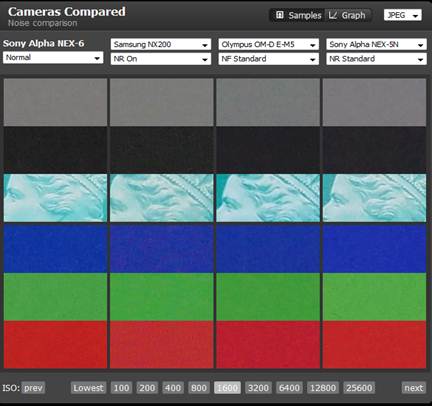
A noise-level
range comparison at an ISO 1,600
The noise levels are basically the same as the NEX-5N’s; the
camera uses the same 16MP CMOS sensor. At higher sensitivities this sensor is
easy to pull ahead the Micro Four Thirds-based Panasonic GX1, though the
Fujifilm E-X1 has the most detail and less noise compared with four cameras
rendered above. If you add the eldest brother of the NEX-6 (the NEX-7) in
combination, you will notice that its noise levels are slightly higher when the
sensitivity attains its upper limits.
Noise reduction
The NEX-6 has two noise reduction settings: low and normal.
As you can see from the chart, the measured noise levels remain the same
throughout ISO 400, after which they diverge. The visible differences do not
show up until around ISO 3,200, at which point details become more mottled at
the low NR setting.
Raw noise (set ACR 7.3 noise reduction to zero)
Here we have a look at the raw files handled through Adobe
Camera Raw (in this case version 7.3). The images are combined with the
brightness and handled with all noise reduction options set to zero. Adobe
performs a noise reduction level even when the user controlled NR is switched
off.
The amount of NR applied 'under the lens cap' is not high,
but it varies with the camera (Adobe is attempting to normalize performance
across different sensors; so make sure that we are still looking for a balance
of noise and noise reduction, rather than pure noise levels. However, the use
of the most common third-party raw converter suite is calculated to provide a
photographically relevant result, rather than simply comparing sensor
performance in an abstract way.
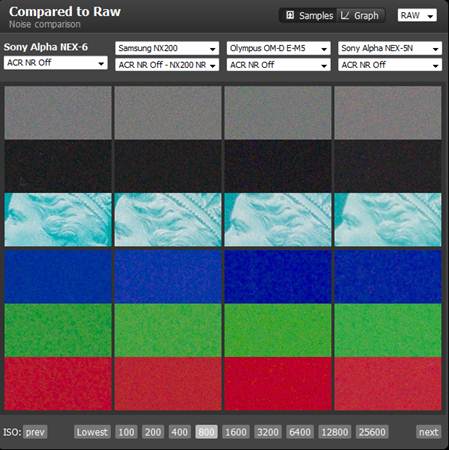
RAW noise
comparison
At lower ISOs, the NEX-6 shows very little chroma noise.
This noise becomes much more remarkable at ISO 1,600, though detail remains the
same until ISO 6,400. At this point you will see that the NEX-6 is again
relatively better than the Panasonic GX1, though not really as clean as the
Fuji X-E1.
Studio scene comparison (JPEG)
This is our standard studio scene comparison image taken
from the same tripod position. Lighting: daylight simulation,> 98% CRI,
Crops are at 100%. The surrounding temperature was around 22 ° C (~ 72 ° F).
Note: this page uses our new interactive studio image
comparison widget.
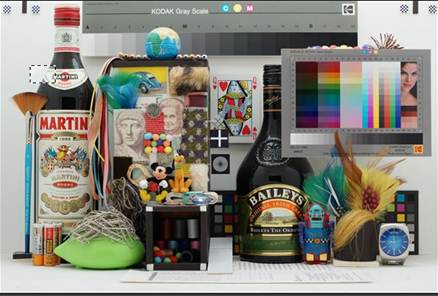
A photo taken in
the studio
Up to ISO 800, both chroma noise and luminance are well
controlled with minimal effect on low contrast detail. The images convey a
pleasant degree of saturation, and overall image quality is what we have
expected from the Sony's NEX cameras, which is to say it's really very good. Up
to ISO 800 in fact, the NEX-6 brings up results which are comparable or optimal
in terms of detail reproduction and noise with amateur cameras and midrange
DSLR of the same type.
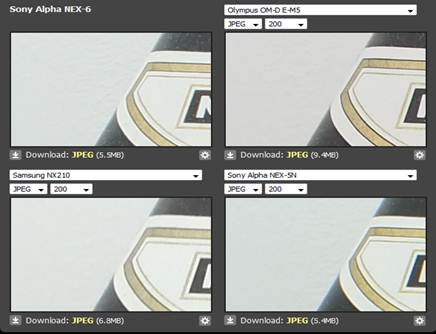
The images convey
a pleasant degree of saturation
Studio scene comparison (JPEG High ISO)
This is our standard studio scene comparison image that we
were shot from the same tripod position. Lighting: daylight simulation,> 98%
CRI, Crops are at 100%. The surrounding temperature is around 22 ° C (~ 72 °
F).
Note: this page uses our new interactive studio image
comparison widget.
At 1,600 and 200 ISO, the low-contrast details start to be
dominated by chroma noise and the effects of noise reduction. However,
high-contrast detail is still pretty well preserved, which helps to retain the
impression of overall resolution. The photos were taken at these medium-high
ISO sensitivity settings were not tiptop when viewed at 100%, but look
acceptable when viewed on the screen in the web galleries or in medium / small
prints.

At 1,600 and 200
ISO
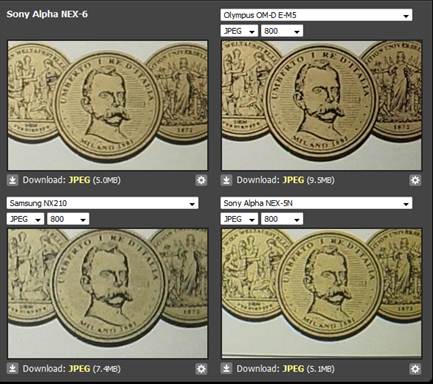
The low contrast
details start to be dominated by chroma noise.
Standard studio scene comparison (Raw)
This is our standard studio scene taken from the same tripod
position. Lighting: daylight simulation,> 98% CRI, Crops are at 100%. The
surrounding temperature is around 22 ° C (~ 72 ° F).
To be fair in comparison we also shot the scenes in the
studio in RAW mode with each camera and converted it by using Adobe Camera Raw.
Since Adobe Camera Raw applied different levels of sharpening with different
cameras (this confirmed) we used the following workflow for this conversion.
·
Load Raw files into Adobe Camera Raw (Auto mode disabled)
·
Set the sharpness to 0
·
Open the file in Photoshop
·
Apply a Unsharp mask that suits the camera, here 100%, radius
0.6, Threshold 0
·
Save as the format of JPEG quality 11 for display and download
At ISO sensitivity settings from 100 to 3,200, the output of
the NEX-6 Raw is sharp and detailed even in low-contrast regions. High and
medium-contrast detail is preserved well in every way up to ISO 3,200. Chroma
noise is relatively limited at these settings.
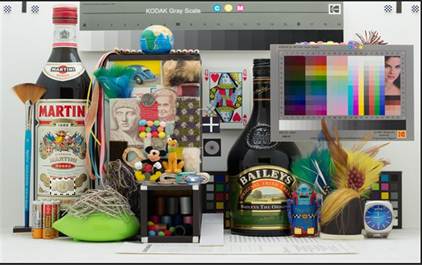
ISO 3,200

High and
medium-contrast detail is preserved well in every way up to ISO 3,200. Chroma
noise is relatively limited at these settings.
Pros
·
The image quality is very good and ISO performance is high.
·
The OLED electronic viewfinder has high resolution.
·
Articulating 920k dot screen
·
Integrated Wi-Fi allows you to share photos with smartphones,
computers, facebook and more
·
PlayMemories Store app lets you add additional features to your
camera
·
Finally, a 'real' hot shoe and mode dial
·
The speeds of focusing and shooting shot-to-shot are good.
·
The AF system tracks objects better than just contrast detection
(at least in good light)
·
Plenty of handy features, such as Auto HDR, maximum focus, Sweep
Panorama, and Hand-held Twilight / Anti Motion Blur
·
Video recording at 1,080/60p with the maximum exposure control
(even while recording) and continuous autofocus
·
Fast continuous shooting performance, with the ability to focus
between each image
·
Customizable function menu and soft buttons
·
Battery life is above average
·
Charging via USB can be very handy
Cons
·
Best image quality contained in Raw images (due to rather strong
noise reduction)
·
A lot of controls still accessed through the clumsy menu-driven
interface
·
Movie recording button has gone from too accessible to
inaccessible.
·
Some apps (such as Multi Frame NR and Time Laspe) are free on the
previous Sony cameras or opponents; no e-mail app comes with.
·
The apps take several seconds to load and can be unstable
·
Converting RAW in the camera will increase the flexibility.
·
Playback mode is wrongly split into stills, MP4 and AVCHD parts
·
16:9 aspect ratio on LCD leaves margin when shooting static
images.
·
The touch screen LCD makes the camera easy to use, especially
when typing on the virtual keyboard.
·
Charging via USB is slow and makes it difficult to use a spare
battery.
·
No 3.5mm input for external mic (only exclusive Sony hot shoe
mics are supported)